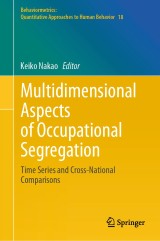Details
Multidimensional Aspects of Occupational Segregation
Time Series and Cross-National ComparisonsBehaviormetrics: Quantitative Approaches to Human Behavior, Band 18
|
128,39 € |
|
| Verlag: | Springer |
| Format: | |
| Veröffentl.: | 29.04.2024 |
| ISBN/EAN: | 9789819985135 |
| Sprache: | englisch |
Dieses eBook enthält ein Wasserzeichen.
Beschreibungen
<p>One of the strengths of this book is that it expresses occupational segregation from multidimensional viewpoints using correspondence analysis. Through a quantitative approach, the book examines occupational segregation by education and gender in response to industrial transformation in Japan and other countries. </p>
<p>The transformation of industrial structure, such as post-industrialization, demands a reconsideration of traditional perspectives in sociology, especially in social stratification. In other words, it is a shift from the attribute to the achievement principle. Higher technological innovations will create higher levels of industries, and those industries will require jobs that need greater human capital. In short, the meritocracy will be promoted.</p>
<p>Meritocracy is certainly considered persuasive. In fact, previous researchers have looked primarily at a person’s occupation as a measure of social status. In Japan, jobs are normally acquired after completing education; thus, one’s educational achievement plays an important role.</p>
<p>Especially in recent years, however, education alone has not been enough to explain social status. This book, therefore, focuses on occupational segregation by gender in addition to education in post-industrial society. Can occupational segregation by gender be weakened in the highly educated group? Is this a universal story in modern society?</p>
<p>Because post-industrialization is part of the larger story of modernization, international perspectives are needed to examine the linkage between education and gender occupational segregation. This book explores occupational segregation by gender in response to industrial transformation in Japan and other countries.</p>
<div> <br><div><div> </div> </div> </div>
<p>The transformation of industrial structure, such as post-industrialization, demands a reconsideration of traditional perspectives in sociology, especially in social stratification. In other words, it is a shift from the attribute to the achievement principle. Higher technological innovations will create higher levels of industries, and those industries will require jobs that need greater human capital. In short, the meritocracy will be promoted.</p>
<p>Meritocracy is certainly considered persuasive. In fact, previous researchers have looked primarily at a person’s occupation as a measure of social status. In Japan, jobs are normally acquired after completing education; thus, one’s educational achievement plays an important role.</p>
<p>Especially in recent years, however, education alone has not been enough to explain social status. This book, therefore, focuses on occupational segregation by gender in addition to education in post-industrial society. Can occupational segregation by gender be weakened in the highly educated group? Is this a universal story in modern society?</p>
<p>Because post-industrialization is part of the larger story of modernization, international perspectives are needed to examine the linkage between education and gender occupational segregation. This book explores occupational segregation by gender in response to industrial transformation in Japan and other countries.</p>
<div> <br><div><div> </div> </div> </div>
Introduction.- Multidimensional Structure of Occupational Segregation by Education and Gender: Time Series Comparison in Japan from 1980 to 2010.- Occupational Segregation by Education and Gender in Japan: Focusing on Employment Status and Marital Status.- Occupation Ssegregation for Immigrants in Japan: Using Custom-Made Census Data in 2010.
<p>Keiko Nakao is at Tokyo Metropolitan University. </p>
<p>One of the strengths of this book is that it expresses occupational segregation from multidimensional viewpoints using correspondence analysis. Through a quantitative approach, the book examines occupational segregation by education and gender in response to industrial transformation in Japan and other countries. </p><p>The transformation of industrial structure, such as post-industrialization, demands a reconsideration of traditional perspectives in sociology, especially in social stratification. In other words, it is a shift from the attribute to the achievement principle. Higher technological innovations will create higher levels of industries, and those industries will require jobs that need greater human capital. In short, the meritocracy will be promoted.</p><p>Meritocracy is certainly considered persuasive. In fact, previous researchers have looked primarily at a person’s occupation as a measure of social status. In Japan, jobs are normally acquired after completing education; thus, one’s educational achievement plays an important role.</p><p>Especially in recent years, however, education alone has not been enough to explain social status. This book, therefore, focuses on occupational segregation by gender in addition to education in post-industrial society. Can occupational segregation by gender be weakened in the highly educated group? Is this a universal story in modern society?</p><p>Because post-industrialization is part of the larger story of modernization, international perspectives are needed to examine the linkage between education and gender occupational segregation. This book explores occupational segregation by gender in response to industrial transformation in Japan and other countries.</p><div><br></div>
Visualizes occupational segregation by educational achievement and gender, through correspondence analysis Provides useful insights for rethinking meritocracy in modern societies based on detailed quantitative analysis Illustrates persuasively the characteristics of the occupational structure in Japan
Diese Produkte könnten Sie auch interessieren:

Bayesian Evaluation of Informative Hypotheses

von: Herbert Hoijtink, Irene Klugkist, Paul Boelen

96,29 €
















